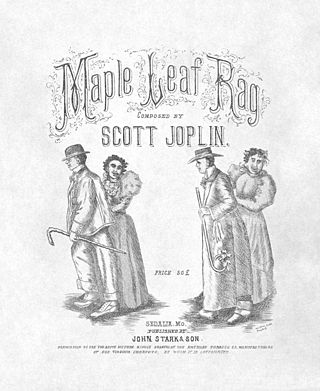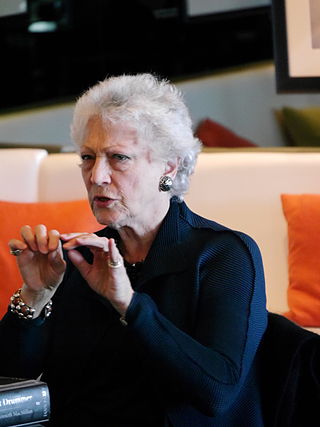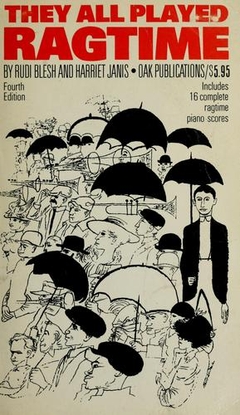Related Research Articles

Ragtime, also spelled rag-time or rag time, is a musical style that had its peak from the 1890s to 1910s. Its cardinal trait is its syncopated or "ragged" rhythm. Ragtime was popularized during the early 20th century by composers such as Scott Joplin, James Scott, and Joseph Lamb. Ragtime pieces are typically composed for and performed on piano, though the genre has been adapted for a variety of instruments and styles.

Scott Joplin was an American composer and pianist. Dubbed the "King of Ragtime", he composed more than 40 ragtime pieces, one ragtime ballet, and two operas. One of his first and most popular pieces, the "Maple Leaf Rag", became the genre's first and most influential hit, later being recognized as the quintessential rag. Joplin considered ragtime to be a form of classical music meant to be played in concert halls and largely disdained the performance of ragtime as honky tonk music most common in saloons.

Joseph Francis Lamb was an American composer of ragtime music. Lamb, of Irish descent, was the only non-African American of the "Big Three" composers of classical ragtime, the other two being Scott Joplin and James Scott. The ragtime of Joseph Lamb ranges from standard popular fare to complex and highly engaging. His use of long phrases was influenced by classical works he had learned from his sister and others while growing up, but his sense of structure was potentially derived from his study of Joplin's piano rags. By the time he added some polish to his later works in the 1950s, Lamb had mastered the classic rag genre in a way that almost no other composer was able to approach at that time, and continued to play it passably as well, as evidenced by at least two separate recordings done in his home, as well as a few recorded interviews.

James Sylvester Scott was an American ragtime composer and pianist. He is regarded as one of the "Big Three" composers of classical ragtime along with Scott Joplin and Joseph Lamb.

The "Maple Leaf Rag" is an early ragtime musical composition for piano composed by Scott Joplin. It was one of Joplin's early works, becoming the model for ragtime compositions by subsequent composers. It is one of the most famous of all ragtime pieces. Its success led to Joplin being dubbed the "King of Ragtime" by his contemporaries. The piece gave Joplin a steady if unspectacular income for the rest of his life.

Classic rag is the style of ragtime composition pioneered by Scott Joplin and the Missouri school of ragtime composers. These compositions were first considered "classic" by Joplin's publisher, John Stark, as a way to distinguish them from what he considered the "common" rags of other publishers. Today, any composition fitting this particular ragtime structural form is considered classic rag.

"The Entertainer" is a 1902 classic piano rag written by Scott Joplin.

Dame Monica Margaret Mason is a former ballet dancer, teacher, and director of The Royal Ballet. In more than a half-century with the company, she established a reputation as a versatile performer, a skilled rehearsal director, and a capable administrator.

Sir Kenneth MacMillan was a British ballet dancer and choreographer who was artistic director of the Royal Ballet in London between 1970 and 1977, and its principal choreographer from 1977 until his death. Earlier he had served as director of ballet for the Deutsche Oper in Berlin. He was also associate director of the American Ballet Theatre from 1984 to 1989, and artistic associate of the Houston Ballet from 1989 to 1992.

"Bethena, A Concert Waltz" is a composition by Scott Joplin. It was the first Joplin work since his wife Freddie's death on September 10, 1904, of pneumonia, ten weeks after their wedding. At the time the composer had significant financial problems; the work did not sell successfully at the time of publication and was soon neglected and forgotten. It was rediscovered as a result of the Joplin revival in the 1970s and has received acclaim from Joplin's biographers and other critics. The piece combines two different styles of music, the classical waltz and the rag, and has been seen as demonstrating Joplin's excellence as a classical composer. The work has been described as "an enchantingly beautiful piece that is among the greatest of Ragtime Waltzes", a "masterpiece", and "Joplin's finest waltz".

"The Ragtime Dance" is a piece of ragtime music by Scott Joplin, first published in 1902.
Max Edward Morath was an American ragtime pianist, composer, actor, and author. He was best known for his piano playing and is referred to as "Mr. Ragtime". He was a touring performer as well as being variously a composer, recording artist, actor, playwright, and radio and television presenter. Rudi Blesh billed Morath as a "one-man ragtime army".
The New England Ragtime Ensemble was a Boston chamber orchestra dedicated to the music of Scott Joplin and other ragtime composers.

"Elite Syncopations" is a 1902 ragtime piano composition by American composer Scott Joplin, originally published in 1903 by John Stark & Son. The cover of the original sheet music prominently features a well-dressed man and lady sitting on a treble staff, looking down upon a cherub clutching a cymbal in each hand, which reflects plainly the title of the piece. In 1974, the British Royal Ballet, under director Kenneth MacMillan, created the ballet Elite Syncopations based on tunes by Joplin and other composers of the era.

This Is Ragtime Now! is an album by American jazz pianist Hank Jones featuring interpretations ragtime tunes recorded in 1964 for the ABC-Paramount label.
Maple Leaf Rag is a storyless Martha Graham ballet set to ragtime compositions by Scott Joplin. The work premiered on October 2, 1990 at New York City Center with costumes by Calvin Klein and lighting by David Finley. Chris Landriau arranged the music and played piano at the debut. The dance is a jubilant self-parody and an homage, of sorts, to Graham's mentor and musical director, Louis Horst, who would play the rag for her whenever she fell into a creative slump. Graham was 96 when she created Maple Leaf Rag; it is her last completed dance. In 1991, she began another work, The Eyes of the Goddess, but it was unfinished at the time of her death.

They All Played Ragtime is a non-fiction book by journalist Rudi Blesh and author Harriet Janis, originally published by Grove Press in 1950. It was subsequently reissued in 1959, 1966, and 1971 by Oak Publications, and in 2007 by Nelson Press. According to the Preface to the Fourth Edition, by Rudi Blesh, the book was conceived and researched largely by Harriet Janis, who died in 1963. It is generally recognized as the pioneering and first serious book to document the history and major composers of ragtime in America, and has been referred to as The Bible of Ragtime.
Glenn Jenks was an American ragtime pianist, composer and music historian.
References
- 1 2 3 4 5 "Elite Syncopations" Archived 2012-05-05 at the Wayback Machine , Kenneth McMillan website, retrieved 22 March 2015
- ↑ "Elite Syncopations" Archived 2006-03-19 at the Wayback Machine , Birmingham Royal Ballet, retrieved 22 March 2015
- ↑ "Elite Syncopations" Archived 2012-04-02 at the Wayback Machine , Royal Opera House retrieved 22 March 2015
- ↑ Percival, John. "Great Scott! Another Joplin ballet", The Times, 8 October 1974, p. 13
- 1 2 Felciano, Rita. "San Francisco Ballet", DanceView 20.4 (Autumn 2003), pp. 29–33